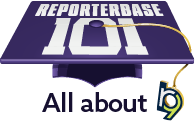Lesson #84
Reports – Gross Profit function
Gross profit is the difference between the invoice amount and resource costs. This static report lists the gross profit (in amount and percentage) for each job or invoice. You can customize the information shown in the report and create summary reports that only show each firm’s total amounts for the selected time period.
The default report shows the gross profit for all of today’s scheduled jobs — broken down by the firm that ordered the services on the invoice (Sold To firm). Each firm’s listing includes their address and phone number to help you identify them correctly.
Every job listed under a firm includes:
- Job number, date, and case
- Invoice number, date, and total amount
- Resource pay
- Resulting gross profit in dollars and by percentage
It also lists any voided or credited amount and the associated deduction to resource pay. At the end of the report are grand totals for invoice amount, voided and credit memo amounts, resource pay, and gross profit in dollars and by percentage.
Find gross profit for different variables
You can view the same information for:
- A different date range
- Invoices billed during the date range
- Invoices posted during the date range
- Firms that ordered the billed jobs, instead of the billed services (Ordering Firm)
- Firms responsible for paying invoices (This is useful to see the gross profit for a carrier/corporation that has multiple firms booking jobs.)
- A single Sold To Firm, Ordering Firm, or Bill To Firm
- A Sold To, Ordering, or Bill To Firm’s parent company
- A particular case
- A selected number of your top clients
- One or more of your company’s business units
The report’s footer will display which search criteria you used to generate the particular report with the exception of blank search fields, ALL list selections, or if generating a report for a single firm. If you select two or more items in the Business Units list, the report will display that as “(multiple values selected).”
View a detailed or summary report
You can also choose a summary version that gives each client one line in the report that lists the firm name, address, and phone number — plus the total amounts for invoice billings, voids/credit memos, resource pay, and gross profit in dollars and percentages.
You can search for a word or phrase in the onscreen report. RB9 will highlight all instances of your searched word/phrase in the report and list them in a scroll box along with the page number where they occur. Export the report in a variety of formats to save, share, and/or edit in another application, or print it.
NOTE: This is an RB9-only function. It is not included in RB Lite.
TL;DR: View gross profit by invoice. Customizable report can also display summary information for each client.
RB concepts in this lesson
Bill To Firm: The firm responsible for paying the invoice for a job. This firm could be the same as the Ordering Firm, but also could be a third-party firm — such as an insurance agency.
Business Unit (BU): One of your company’s revenue centers or any entity in your business that you want to track separately.
Firm: Business you provide services to— usually law firms.
Job: Usually the reporting of a deposition, but can also be any kind of service you provide with your reporters or other resources, such as realtime, videoconferencing, or read & sign. More >
Ordering Firm: Firm that is responsible for a job with your company.
Parent Firm: Headquarters of a multi-branch corporation.
Resource: Person or thing that provides your business with a service — such as reporters, videographers, interpreters, scopists, proofreaders, account executives, other agencies that cover jobs for you, or a conference room.
Sold To Firm: Firm that ordered the services on the invoice. Usually the firm that ordered a job.

